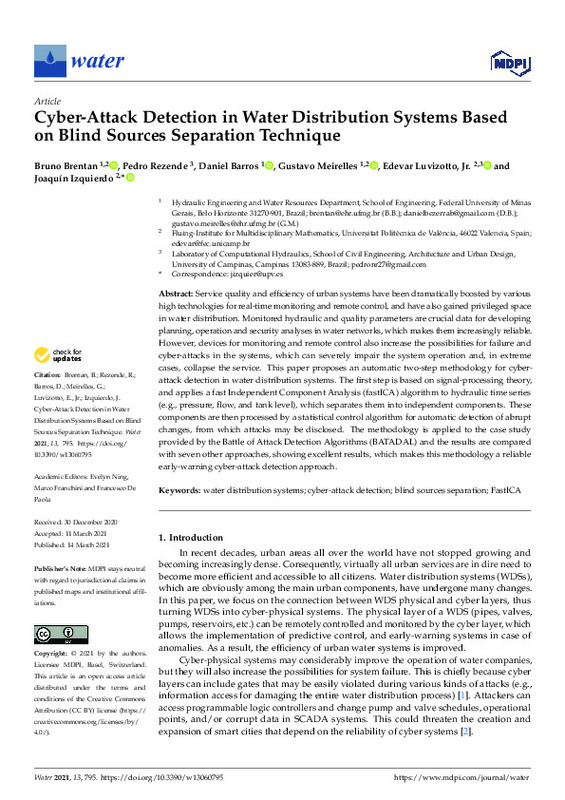JavaScript is disabled for your browser. Some features of this site may not work without it.
Buscar en RiuNet
Listar
Mi cuenta
Estadísticas
Ayuda RiuNet
Admin. UPV
Cyber-Attack Detection in Water Distribution Systems Based on Blind Sources Separation Technique
Mostrar el registro sencillo del ítem
Ficheros en el ítem
| dc.contributor.author | Brentan, Bruno
|
es_ES |
| dc.contributor.author | Rezende, Pedro
|
es_ES |
| dc.contributor.author | Barros, Daniel
|
es_ES |
| dc.contributor.author | Meirelles, Gustavo
|
es_ES |
| dc.contributor.author | Luvizotto, Edevar
|
es_ES |
| dc.contributor.author | Izquierdo Sebastián, Joaquín
|
es_ES |
| dc.date.accessioned | 2022-01-10T19:31:39Z | |
| dc.date.available | 2022-01-10T19:31:39Z | |
| dc.date.issued | 2021-03-14 | es_ES |
| dc.identifier.issn | 2073-4441 | es_ES |
| dc.identifier.uri | http://hdl.handle.net/10251/179426 | |
| dc.description.abstract | [EN] Service quality and efficiency of urban systems have been dramatically boosted by various high technologies for real-time monitoring and remote control, and have also gained privileged space in water distribution. Monitored hydraulic and quality parameters are crucial data for developing planning, operation and security analyses in water networks, which makes them increasingly reliable. However, devices for monitoring and remote control also increase the possibilities for failure and cyber-attacks in the systems, which can severely impair the system operation and, in extreme cases, collapse the service. This paper proposes an automatic two-step methodology for cyber-attack detection in water distribution systems. The first step is based on signal-processing theory, and applies a fast Independent Component Analysis (fastICA) algorithm to hydraulic time series (e.g., pressure, flow, and tank level), which separates them into independent components. These components are then processed by a statistical control algorithm for automatic detection of abrupt changes, from which attacks may be disclosed. The methodology is applied to the case study provided by the Battle of Attack Detection Algorithms (BATADAL) and the results are compared with seven other approaches, showing excellent results, which makes this methodology a reliable early-warning cyber-attack detection approach | es_ES |
| dc.language | Inglés | es_ES |
| dc.publisher | MDPI AG | es_ES |
| dc.relation.ispartof | Water | es_ES |
| dc.rights | Reconocimiento (by) | es_ES |
| dc.subject | Water distribution systems | es_ES |
| dc.subject | Cyber-attack detection | es_ES |
| dc.subject | Blind sources separation | es_ES |
| dc.subject | FastICA | es_ES |
| dc.subject.classification | MATEMATICA APLICADA | es_ES |
| dc.title | Cyber-Attack Detection in Water Distribution Systems Based on Blind Sources Separation Technique | es_ES |
| dc.type | Artículo | es_ES |
| dc.identifier.doi | 10.3390/w13060795 | es_ES |
| dc.rights.accessRights | Abierto | es_ES |
| dc.contributor.affiliation | Universitat Politècnica de València. Departamento de Matemática Aplicada - Departament de Matemàtica Aplicada | es_ES |
| dc.description.bibliographicCitation | Brentan, B.; Rezende, P.; Barros, D.; Meirelles, G.; Luvizotto, E.; Izquierdo Sebastián, J. (2021). Cyber-Attack Detection in Water Distribution Systems Based on Blind Sources Separation Technique. Water. 13(6):1-16. https://doi.org/10.3390/w13060795 | es_ES |
| dc.description.accrualMethod | S | es_ES |
| dc.relation.publisherversion | https://doi.org/10.3390/w13060795 | es_ES |
| dc.description.upvformatpinicio | 1 | es_ES |
| dc.description.upvformatpfin | 16 | es_ES |
| dc.type.version | info:eu-repo/semantics/publishedVersion | es_ES |
| dc.description.volume | 13 | es_ES |
| dc.description.issue | 6 | es_ES |
| dc.relation.pasarela | S\430560 | es_ES |
| dc.subject.ods | 09.- Desarrollar infraestructuras resilientes, promover la industrialización inclusiva y sostenible, y fomentar la innovación | es_ES |








